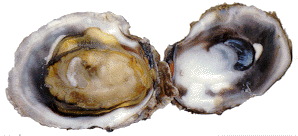|
Species
Thirteen species of edible oysters have been reported from India among which, four
species viz., Crassostrea gryphoides, C. rivularis, C. madrasensis
and Saccostrea cucullata are of commercial value. C. gryphoides
and C. rivularis are mostly found in the North-Western coast of India.
Crassostrea madrasensis enjoys a wider distribution along the South-West
and East coasts of India and it is found in almost all the estuaries and backwaters.
C. madrasensis is euryhaline i.e., it tolerates wide variations in salinity.
It inhabits backwaters, creeks, bays and lagoons and occurs, from the intertidal
region to 17 m depth. It is predominantly found in Orissa, Karnataka and Andhra
Pradesh. Tamil Nadu also has rich oyster resources. In the Pulicat backwater oyster
beds cover 10 ha with an estimated standing stock of 1,320 t. In the Ennore backwater
45 ha oyster beds support a standing stock of 18,600 t and the oysters are regularly
exploited by fisherfolk throughout the year. The Kerala coast supports small oyster
populations. In the Ashtamudi and Vembanad lakes, Cochin backwaters, Mahe estuary
and the creeks of Dharmadam, Valapatinam, Nileshwar and Chandragiri, oyster populations
have been recorded and there is regular exploitation.
C. gryphoides is also a euryhaline species occurring along the north Karnataka,
Goa and Maharashtra coasts. In Maharashtra it is exploited regularly from several
creeks. It occurs in waters upto 7 m depth. C. rivularis is found along
the Gujarat coast and also occurs in Maharashtra together with C. gryphoides
in the Mahim, Ratnagiri and Jaytapur creeks. Saccostrea cucullata
occurs all along the main land coast and Andaman and Lakshadweep Islands. It is
found in shallow coastal waters, attached to the rocks and boulders and can withstand
surf and wave action in the marine environment.
|

Crassostrea madrasensis
|

Crassostrea gryphoides
|
|

Crassostrea rivularis
|

Saccostrea cucculata
|
Distinctive Characters
The shape of the oyster shell is highly variable. If grown individually on a soft
bottom, the shell tends to be smooth and elongate. If grown individually attached
to a surface, the lower valve grows attached to the surface rather flat, thus loosing
the normal cupped appearance.
The various genera and species are identified based on the shape, size, colour and
other characteristics of the shell, and the breeding habits.
C. madrasensis : Shell valves irregular
in shape, usually elongate. Left valve deep and the right one slightly concave;
hinge narrow and elongated. Adductor muscle is kidney-shaped and dark purple. Grows
to 22 cm.
C. gryphoides : Shell valves elongate
and thick. Left valve cup like. Hinge area well developed and has a deep median
groove with lateral elevations. Adductor muscle scar is broad, more or less oblong
and striations on the scar are absent or obscure. Grows to 17 cm.
C. rivularis : Shell valves large,
roughly round, flat, thick and with a shallow shell cavity. Left valve is thick
and slightly concave and the right one is about the same size or slightly larger.
Adductor muscle scar is oblong and white or smoky white in colour. Grows to 15 cm.
S. cucullata : Shell valves hard,
stony, trigonal and pear-shaped. Hinge straight, devoid of teeth and umbonal cavity
well developed. The margins of both the valves have well developed angular folds
sculptured with laminae. Small tubercles present along the inner margin of the right
valve and there are corresponding pits in the left valve. Adductor scar is kidney-shaped,
striated and white or grey in colour.
Biology
The edible oyster is a sedentary animal. It attaches to the substratum by the cupped
lower valve (left) and the upper (right) valve acts as a lid. The antero-posterior
axis (long axis) is the height but in common usage it is called length. The actual
length of the oyster (dorso-ventral axis) is referred to as width in common usage.
The food consists of organic detritus and phytoplankters such as diatoms and nanoplankters.
The growth is related to food availability and also to the environmental conditions,
particularly to salinity and temperature. In the Cochin backwaters, spat of 10 mm
nodal length grow to 55 mm nodal length in about 6 months.
In the genus Crassostrea, sexes are separate but occasionally hermaphrodites
occur. The ovary and testis consist of a series of branching tubules, also called
follicles, on either side of the body. During spawning, ripe eggs and sperms are
discharged into the exterior where fertilization takes place.
Exploitation
The oysters occur in shallow waters and form subsistence fisheries at several
centres along the Indian Coast. The production is mostly utilised for local consumption.
Men, women and children collect the oysters at low tide and various implements are
used to dislodge the oysters from the bed. The production of the oysters from the
natural grounds is not monitored regularly in the country.
Seed collection
Oyster seed are procured from the natural resources by placing suitable collectors
called cultch in the water column at appropriate period. This practice is still
in vogue in several countries even though hatcheries are increasingly supplying
the seed for farming. During spawning seasons the spat collectors are laid on the
bottom, on the racks or suspended from racks. If the collectors are laid in advance
of spat fall, they may be covered with silt or settlement of foulers, making them
unsuitable for the oyster larvae to settle. The larval period in C. madrasensis
is 15-20 days. The ideal time for laying the spat collectors in the water is
about 7-10 days after peak spawning.
Of the two spawning periods, April-May is more productive than August-September
for laying the spat collectors. Tiles laid in the Bay gave a high production of
316 spat/m2 compared to 92.3/m2 in the oyster bed and 76.9/m2
in the creek.
Top
|